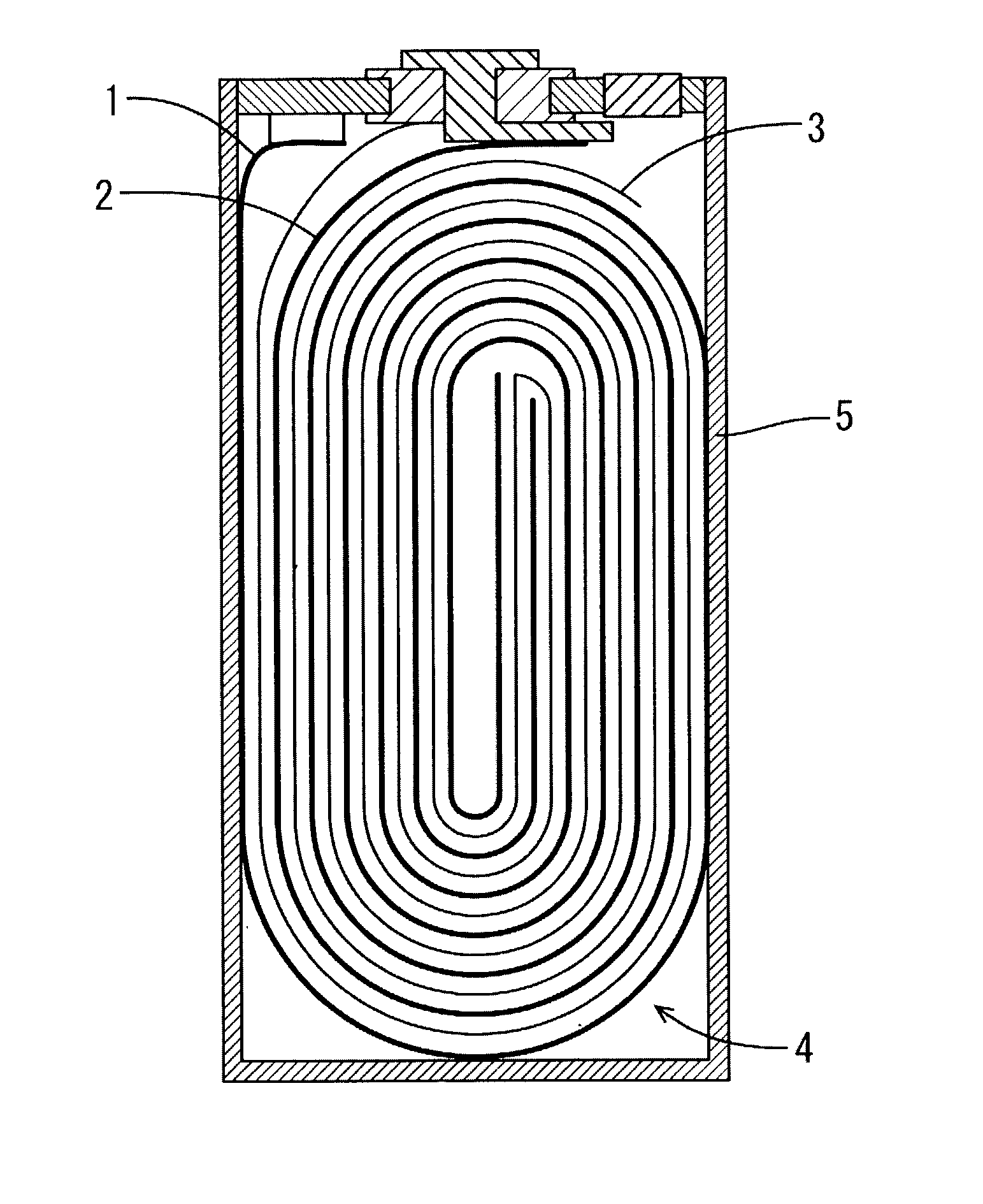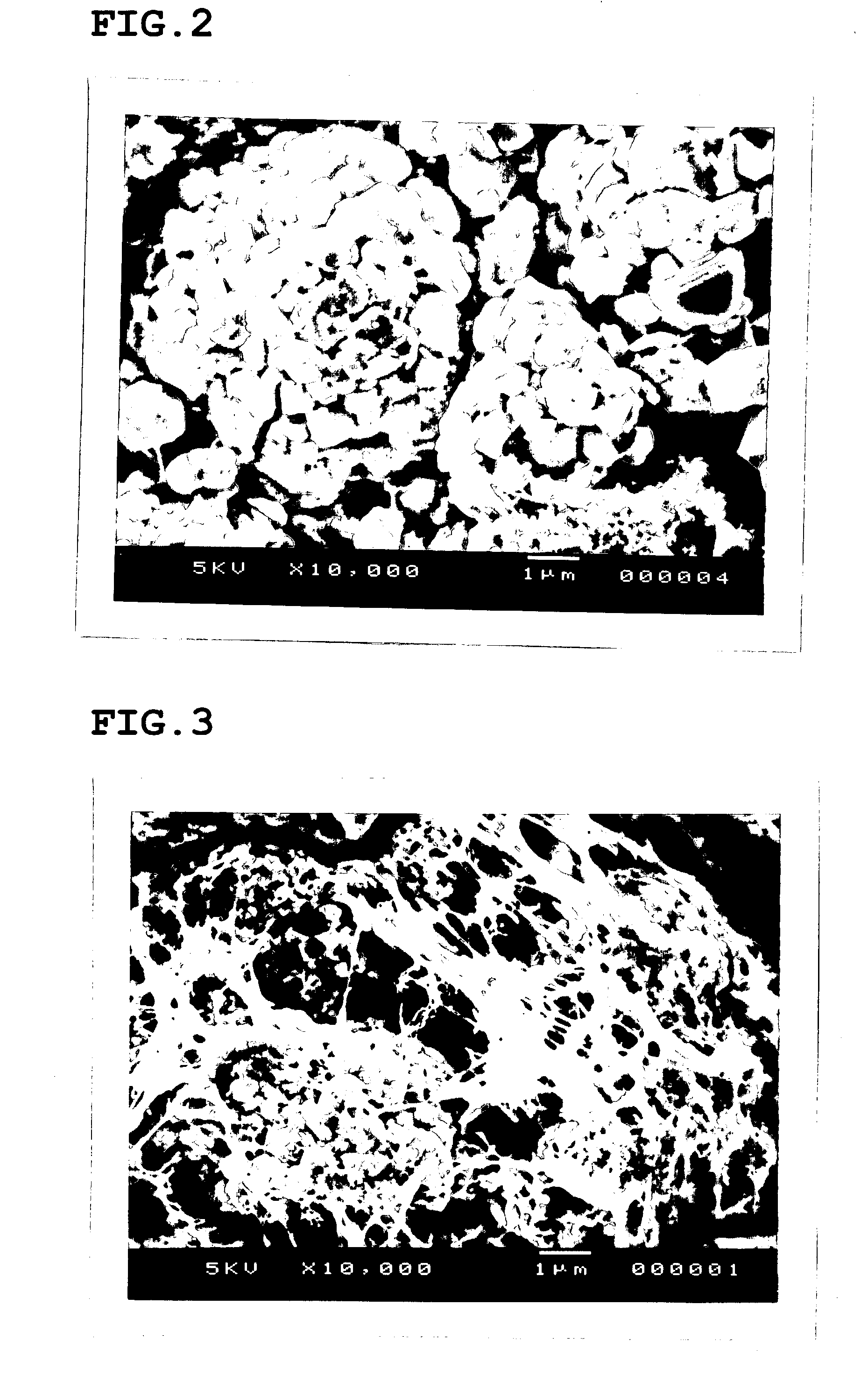Nonaqueous electrolyte cell and its manufacturing method
a manufacturing method and electrolyte technology, applied in the direction of non-aqueous electrolyte cells, cell components, sustainable manufacturing/processing, etc., can solve the problems of drastic decrease in discharge performance, lack of electrolyte limit, poor safety as a technical problem,
- Summary
- Abstract
- Description
- Claims
- Application Information
AI Technical Summary
Benefits of technology
Problems solved by technology
Method used
Image
Examples
example 1
[0041] The positive electrode was produced as follows. First, lithium nickelate(LiNi.sub.0.85Co.sub.0.15O.sub.2) 55 wt %, acetylene black 2 wt %, PVdF 4 wt %, and NMP 39 wt % were mixed and the mixture was applied to the both sides of aluminum foil with 100 mm width, 600 mm length, 20 .mu.m thickness, followed by drying at 100.degree. C. The coated foil was cut to be the thin electrode with size of 26 mm width and 495 mm length, after pressing it from 270 .mu.m to 165 .mu.m in thickness.
[0042] The negative electrode was produced as follows. First, graphite 50 wt %, PVdF 5 wt %, and NMP 45 wt % were mixed and the mixture was applied to the both sides of cupper foil with 100 mm width, 600 mm length, 10 .mu.m thickness, followed by drying at 100.degree. C. The coated foil was cut to be the thin electrode with size of 27 mm width and 450 mm length, after pressing it from 250 .mu.m to 195 .mu.m in thickness.
[0043] The assembly element wounded the positive electrode and negative electrode...
example 2
[0049] The effect of concentration of carbon dioxide gas within the cells on the cycle performance was investigated at the higher temperature. The manufacture process of assembly elements comprising positive electrode, negative electrodes and separators was the same as the case of group(A) in example 1. The value of concentration for carbon dioxide gas was 0.5%, 1%, 10%, 20%, 30%, 40%, 50%, 60%, 70%, 80%, 90%, and 98 vol. %. The cell injected only with air was prepared for reference in comparison; the concentration of carbon dioxide gas was 0.03 vol. %. The amount of electrolyte was 50% of the total pores of the assembly elements comprising electrodes and separators. The cycle performance tests of these 13 types of cells in total were conducted at higher temperature under the similar condition of example 1. FIG. 6 shows the relation between the discharge capacity at the 100th cycle and the concentration of carbon dioxide gas. FIG. 7 shows the relation between the cell thickness at t...
example 3
[0050] The non-aqueous electrolyte cells with the positive electrode, the negative electrodes, and the separator applied the porous polymer electrolyte in the pores of their assembly elements were produced and the 12 types of cells with different amounts of electrolyte were prepared according the following procedure. These cells were named group(D). As for the positive electrodes, lithium nickelate (LiNi.sub.0.85Co.sub.0.15O-.sub.2) 55 wt %, acetylene black 2 wt %, PVdF 4 wt %, and NMP39 wt % were mixed and the mixture was applied to the both sides of aluminum foil with 100 mm width, 600 mm length, 20 .mu.m thickness, followed by drying at 100.degree. C. As for the negative electrode, graphite 50 wt %, PVdF 5 wt %, and NMP 45 wt % were mixed and the mixture was applied to the both sides of cupper foil with 100 mm width, 600 mm length, 10 .mu.m thickness, followed by drying at 100.degree. C. The positive and negative electrodes were immersed in 6 w % and 4 wt % P(VdF / HFP) respectivel...
PUM
| Property | Measurement | Unit |
|---|---|---|
| Fraction | aaaaa | aaaaa |
| Fraction | aaaaa | aaaaa |
| Percent by volume | aaaaa | aaaaa |
Abstract
Description
Claims
Application Information
 Login to View More
Login to View More - R&D
- Intellectual Property
- Life Sciences
- Materials
- Tech Scout
- Unparalleled Data Quality
- Higher Quality Content
- 60% Fewer Hallucinations
Browse by: Latest US Patents, China's latest patents, Technical Efficacy Thesaurus, Application Domain, Technology Topic, Popular Technical Reports.
© 2025 PatSnap. All rights reserved.Legal|Privacy policy|Modern Slavery Act Transparency Statement|Sitemap|About US| Contact US: help@patsnap.com



